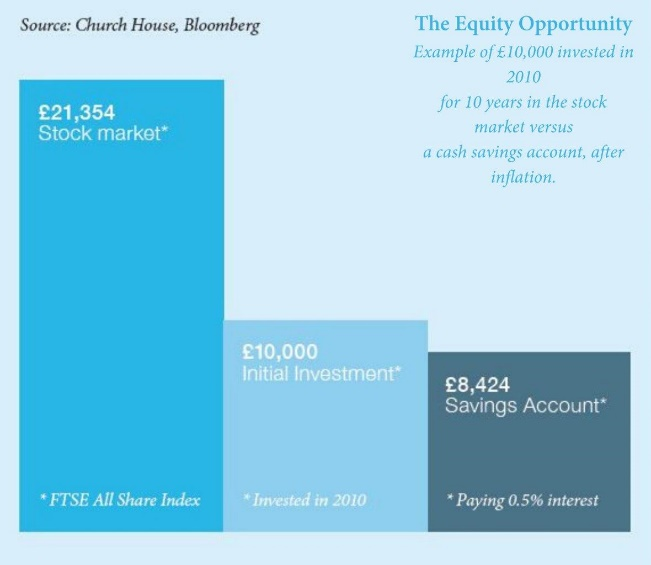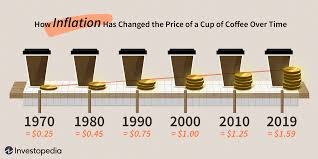With unprecedented levels of market volatility at the start of the year, thanks to COVID-19, where are we now halfway through 2020?
What are the opportunities and threats to investors at this time? We examine the impending threat of inflation, how equities have behaved historically versus cash, the benefits of a liquid and diversified portfolio of investments, as well as where market opportunity lies.
The graph, see right, highlights the historic returns of cash versus the stock market over the last 10 years. As an example, if you had invested £10,000 in the stock market (as illustrated by the FTSE All share Index) in January 2010, it would have been worth £21,354 after 10 years. This assumes the re-investment of any dividend income and an adjustment for inflation. In a cash savings account paying an average of 0.5% interest over the same period, and again adjusted for inflation, the same investment would have been worth £8,424 after 10 years. The reduction in value of cash is due to inflation which has averaged 2% over this 10 year period (as confirmed by the Office of National Statistics in the UK), meaning that if you kept savings in cash, earning the average rate of interest on offer of 0.5%, you were effectively losing 1.5% every year.
Inflation
The graph, see right, is a stark reminder of the risk of keeping your hard earned savings in cash. For those who might not be entirely clear about what inflation actually means, it is the rate at which the general level of prices for goods and services is rising, thereby eroding the value of the cash you hold.
As an everyday example, we can look at the price of a cup of coffee. This has been researched by Investopedia, who created the chart, see right (in dollars but of course inflation applies in all currencies). The year 2020 has been left off, but to buy a coffee from your favourite local coffee shop can now be as much as $2.50. This means that $100 in the year 2000, when a coffee would have only cost $1.00, could have bought you 100 coffees. The rising price of coffee (i.e. inflation) means that same $100 can now only buy you 40 coffees.
It is widely expected that within a year or so post COVID-19, inflation will start to increase. For a start, although oil prices are currently low, retail fuel and energy prices are bound to pick up with global demand. This affects the costs of living of every household worldwide – heating, fuel, food, etc. The increase in inflation will be seen across a range of goods and services. As stay-at-home restrictions are removed, demand will likely roar back. Families will flock to restaurants, shops (as seen in the UK this week), shows, and mini-breaks — anything to leave their homes. The recovery in demand is likely to be much swifter than the recovery in supply and it will take some time for dislocations in global supply chains to be resolved. Furthermore, service providers will be keen to recoup the losses of the spring and early summer. Some companies will be able to raise their prices if some of their competitors have not made it through lockdown.
So how do you protect your savings from being eaten away by inflation? Consider investing. The primary benefit of investing is to preserve your portfolio's buying power – you are buying into the companies who are increasing their prices in line with inflation and other market factors, thereby helping to retain the “real” value of your investment, and ideally growing your nest egg. Investing can also lead you to diversify - spreading the risk across a variety of holdings is a time-honoured method of portfolio construction that is as applicable to inflation-fighting strategies as it is to asset-growth strategies.
Diversification
Diversification is an important risk management strategy that mixes a variety of investments within a single portfolio. By holding a mix of distinct asset types, your Investment Manager can limit exposure to any single asset class or risk. Diversification strives to smooth out unsystematic risk - risk that is inherent in a specific company or industry. The benefits of diversification hold only if the securities (and currencies) in the portfolio are not perfectly correlated—that is they respond differently to market influences.
Historically, portfolios constructed of different kinds of assets have yielded higher long-term returns and lowered the risk than that of individual holdings or securities. One asset class that investors tend to be “overweight” in is property. But remember that it is important to diversify and hold other assets too, to reduce your risk. If markets turn, we cannot change the direction of the wind, but we can adjust the sails if we have a spread of assets.
Liquidity
When looking to diversify, you should consider if your assets are “liquid”, i.e. can you sell the asset easily converting it to cash in a short amount of time. Cash is the most liquid asset. However, some investments are easily converted to cash, like shares, gilts and bonds. So they are also referred to as liquid assets. Land, real estate, or buildings are considered the least liquid assets because it could take weeks or months to sell them. The same can be said for assets like wine or cars, since these items take time to sell, and in order to release cash quickly, you may have to accept a price well below what you believe the asset to be worth.
Timing
Equity markets have fallen decisively since January 2020 when Wuhan went into lockdown, but have stabilised during April, May and June. So is now a good time to invest some cash reserves into the market? If you are a long-term investor with a minimum 5 year time horizon, and you have cash reserves to cover contingencies, then yes, investing cash that would otherwise be in the bank producing next to zero returns (or a negative return after inflation) makes good sense at current levels. Why? Because you are buying into today’s market but at 2016 prices. It has been noted that financial markets are the only “shop” in which you hoist up a sign saying “33% off” and everyone rushes for the exits!
In contrast, our investment team were buying selectively throughout March and April, adding to existing holdings at attractively lower levels and initiating positions in companies we had long wanted but previously considered too expensive. In the short-term, markets may well take another tumble on bad news, in which case we will utilise the opportunity to invest more of the cash we continue to hold as dry powder during these uncertain times. But unless you believe people are going to stop spreading marmite on their toast, why would you not add to a long term holding like Unilever 30% cheaper than you could last year?
If you are interested in exploring investment opportunities, please contact Emma Parkes at e.parkes@church-house.co.uk
Important information
The contents of this article are for information purposes only and do not constitute advice or a personal recommendation. Investors are advised to seek professional advice before entering into any investment decisions. Please also note the value of investments and the income you get from them may fall as well as rise and there is no certainty that you will get back the amount of your original investment. You should also be aware that past performance may not be a reliable guide to future. performance.
How would you like to share this?



